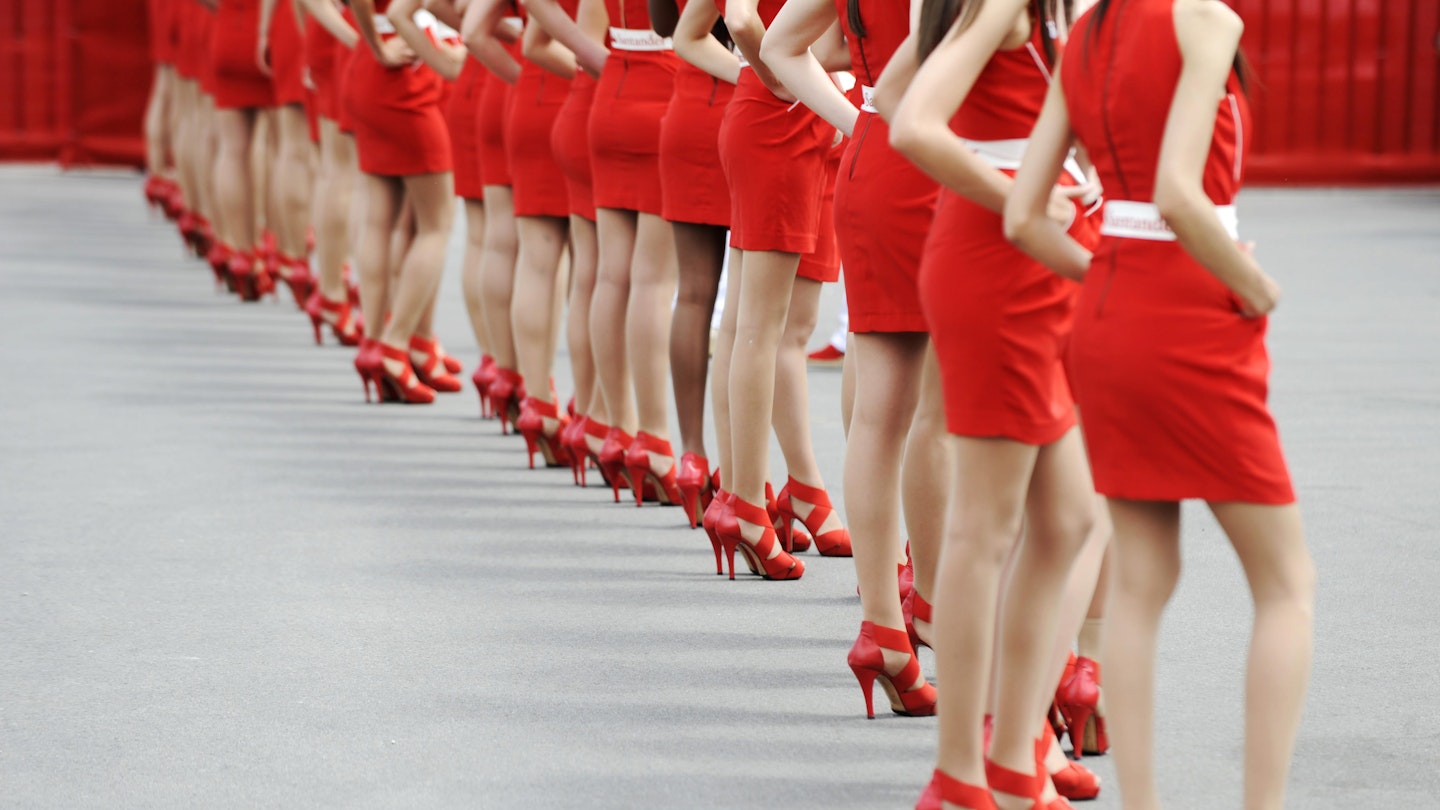First it was darts, now Formula One has become the latest sport to announce that it will stop using grid girls at their events. Boxing, however, will not be following suit and we will continue to see ring card girls at boxing events.
First things first, how are we defining grid girls? They are the (usually young) women who stand on podiums or hold score cards while (more often than not) wearing reasonably little. This, in and of itself, isn’t necessarily a bad thing. After all, it’s every woman’s prerogative to wear as many or as few clothes as she likes and climb atop any podium she comes across. That said, the decision to do away with grid girls in these particularly male-dominated sports is significant.
Car racing, in particular, is a bloke’s sport. Men drive the cars, women present awards, look nice and stand around the winners, almost as prizes in their own right. Grid girls have both been used to promote the sport and as a representation of what might be available to any male competitor who succeeds at it.
This matters because it sends the message to young women that, when it comes to motor racing, a woman’s place is on the sidelines, in a supporting role, and not the starting line. In 2015, Formula One driver Lewis Hamilton was widely criticized after he sprayed champagne in the face of one of the podium girlswaiting for him at the finish line as he celebrated winning the Chinese Gran Prix.
The pictures made uncomfortable viewing, the grid girl in question stayed still and composed while Hamilton stood in close proximity as he sprayed champagne directly into her face. The unnamed woman looks deeply uncomfortable but remains standing in position while Hamilton carries on. Whether or not she wanted him to stop, we may never know, but the image of a high profile and celebrated man acting in such a way sent a message to young women (and men) that this sort of behavior was acceptable.
Grid girls, podium girls and ring girls have exemplified sex object culture so it can only be a good thing that officials in both darts and motor racing have decided to declare the practice as ‘outdated’. Speaking to The Times, Sean Bratches, the managing director of commercial operations at Formula One, said:
‘Over the last year we have looked at a number of areas which we felt needed updating . . . While the practice of employing grid girls has been a staple for decades, we feel this custom does not resonate with our brand values and clearly is at odds with modern day societal norms. We don’t believe the practice is appropriate or relevant to Formula One and its fans, old and new, across the world.’
However, not everybody is happy about the ban. The model Kelly Brook, who is herself a former grid girl, has said that it was ‘one of the best jobs’ she ever had. Brook went on to say ‘you dress glamorously and obviously it’s about being presentable but I never felt I was taken advantage of’. Similarly, darts walk-on girls Charlotte Wood and Daniella Allfree, told ITV’s This Morning that they felt the sport was giving into ‘snowflakes’ and that they enjoyed their jobs. A petition to overturn the ban on walk-on girls in darts has now got over 30,000 signatures. It’s worth noting that it was (as you might expect) started by a man.
While you may argue that it is a woman’s right to choose what work she does and doesn’t do, there is a bigger picture to consider. Broadly speaking, you can’t ignore the inherent sexism that surrounds these roles. Employing women solely in a decorative fashion, to adorn and praise successful men is nothing other than problematic. As with anything, context is key. The problem here is not women's bodies, nudity or sexuality. It is the monopolization of those things by men in a male-dominated sphere.
The sexual objectification of women by mainstream media has been found to have a profoundly negative impact on women’s mental health. More than this, sexual objectification, sexism and sexual violence are not separate issues. All three problems are completely interlinked. As a study from NYU’s Department of Applied Psychologyexplains, ‘a sexist joke and an act of sexual violence might be dismissed as two very different and unrelated events, but they are in fact related. These two behaviors are connected by the presence of sexual objectification. Culturally common and often condoned [by Western culture], the sexual objectification of women is a driving and perpetuating component of gender oppression, systemic sexism, sexual harassment, and violence against women.’
When women are sexually objectified, the worth of their bodies or body parts are directly equated to their physical appearance which, directly, leads us onto their potential sexual function. From there the implication is that a woman’s body exists solely for others to use, view or consume. This is why the existence of grid girls, ring girls and walk-on girls it is problematic despite seeming like innocuous ‘harmless fun’. Indeed, research shows that the prevalence of such objectifying images also leads to young women internalizing negative ideas about their own bodies. As the researcher at NYU points outthis manifests in the form of ‘self-objectification, and it characterized by varying levels of thoughts and behaviors such as self-conscious body monitoring, surveillance, and comparison of one’s body or body parts to the cultural standard or ideal’. The mental health implications are ‘depression, disordered eating, and reduced productivity’. This is known as ‘objectification theory’.
**READ MORE: The Debrief Investigates: Hormonal Contraception And Mental Health **
Debrief Mad About The Pill Stats
 1 of 9
1 of 9Debrief Mad About The Pill Stats
 2 of 9
2 of 9Debrief Mad About The Pill Stats
 3 of 9
3 of 9Debrief Mad About The Pill Stats
 4 of 9
4 of 9Debrief Mad About The Pill Stats
 5 of 9
5 of 9Debrief Mad About The Pill Stats
 6 of 9
6 of 9Debrief Mad About The Pill Stats
 7 of 9
7 of 9Debrief Mad About The Pill Stats
 8 of 9
8 of 9Debrief Mad About The Pill Stats
 9 of 9
9 of 9Debrief Mad About The Pill Stats
A good litmus test for whether something is sexist or not is to ask yourself, ‘does it work the other way around?’ Do women boxers, cyclists, Formula One drivers or athletes in any field look to the finish line to see conventionally attractive, heteronormative scantily clad men holding bouquets of flowers for them? No. So, then, we must ask why the ‘tradition’ of women playing this role in men’s sports exists? The answer can only be that, historically, women have not been valued as highly for their abilities as men in our society.
Another good test is to ask 'who profits from the objectification of women'?. Grid girls, ring girls and darts walk-on girls may be paid for their time but they are not the ones accusing fortunes from those sports. Formula One, for instance, is co-owned by several companies the chairs of which are...you guessed it...men such as Bernie Ecclestone.
In a statement, the Women’s Sport Trust has called for all sports to end their use of scantily clad women at events, saying: ‘This is not a matter of feminists versus models, which seems to be the way many people want to portray this story. These changes are taking place because global businesses are making a considered choice about how women should be valued and portrayed in their sports in 2018. They deserve significant credit for doing so'.
Making women redundant from these jobs isn't going to do away with sexism in sport but perhaps it's the start of a broader conversation that might lead to us celebrating women, not just for their appearances, but their abilities too.
Follow Vicky on Twitter @Victoria_Spratt
This article originally appeared on The Debrief.
